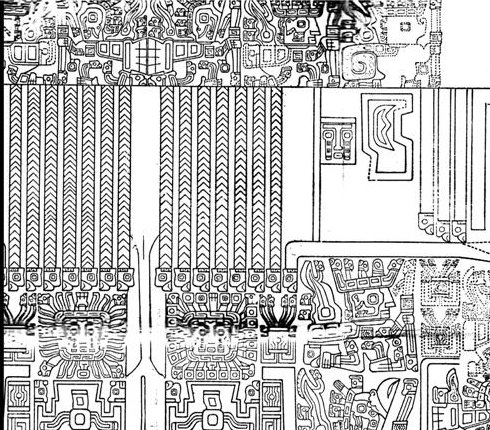We should remember the tresses on the back side of the Pachamama stone statue (also located south of the equator):
With my best efforts I tried to count and finally reached 214½ at her left side. Possibly it means 14h divided her tresses:
The Chinese saw here κ Virginis as the relevant star, rising heliacally in October 21 and 7 months after March 21. The Arabs and the Hindu preferred October 22 - and possibly also the creator of the C text because he evidently began his text with March 22. Furthermore, he created a most complicated glyph where Arcturus and Syrma rose with the Sun (183 days after RA day 32). Counting from March 21 to October 29 there are 295 - 80 = 215 days. But counting the heliacal days from March 21 to April 22 in the next year there were 399 days. Probably it was Jupiter - the 'Father (of) Light' - who 'expired' at Cb1-6.
After once again having contemplated the tresses of Pachamama I think we should first perceive that they are at her back side, which means not out in the Sun-light, not in the daytime. Her back side measures ca 400, which is divided into approximately 185 + 214 nights. The difference between her left and right side tresses is ca 214 - 185 = 29 nights. Given a basic cosmic structure - similar to that in rongorongo - which measured time in multiples of months with 29 nights, I guess the reason for these extra 29 nights could be a wish to expand the night side compared to the daytime side - in order to add 'one more' in the night. To indicate that 'birth' occurs in the night. If a day was beginning ('born') at midnight, then its first half would end at noon, and in the tresses this could correspond to her right side. Her left side - reflecting the 2nd half of the day ('night') - would then begin at noon and in 'autumn' (fall) would the fruits be falling. Spring is where the young ones are growing up, noon is when they are fully grown and mature, and finally comes the time for generating 'fruits' (hua). 
These 'fruits' are transferring life from one generation to the next.
... And then the bone spoke; it was there in the fork of the tree: Why do you want a mere bone, a round thing in the branches of a tree? said the head of One Hunaphu when it spoke to the maiden. You don't want it, she was told. I do want it, said the maiden. Very well. Stretch out your right hand here, so I can see it, said the bone. Yes, said the maiden. She stretched out her right hand, up there in front of the bone. And then the bone spit out its saliva, which landed squarely in the hand of the maiden. And then she looked in her hand, she inspected it right away, but the bone's saliva wasn't in her hand. It is just a sign I have given you, my saliva, my spittle. This, my head, has nothing on it - just bone, nothing of meat. It's just the same with the head of a great lord: it's just the flesh that makes his face look good. And when he dies, people get frightened by his bones. After that, his son is like his saliva, his spittle, in his being, whether it be the son of a lord or the son of a craftsman, an orator. The father does not disappear, but goes on being fulfilled. Neither dimmed nor destroyed is the face of a lord, a warrior, craftsman, an orator. Rather, he will leave his daughters and sons. So it is that I have done likewise through you ... Also our Gregorian calendar exhibits this trait, having expanded the 2nd half of the year in order to make room for (as I guess) 'one more':
The 'added room' is here 193 - 172 = 21 days. Perhaps these 3 weeks arrive at midsummer, because 172 (June 21) + 21 = 193 (July 12). The 29 nights added according to the Pachamama tresses could have arrived at April 21 (111) because (27 + 26) + (29 + 29) = 111. Possibly the creator of the C text thought so too. And the Chinese.
It looks as if Hevelius has put κ Virginis at her left heel. Counting from Alamak (at the heel of Andromeda) to κ Virginis the distance is 214.8 - 29.7 = 185 days. This distance could therefore express the front side of the year. | |||||||||||||||||||||||||||||||||||||||||||||||||||||||||||||||||||||||||||||||||||||||||||||||||||||||||||||||||||||||||||||










